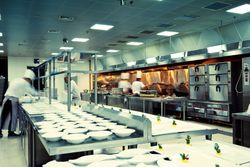Do's & Don'ts of Designing a Commercial Kitchen

From an efficient layout to dependable commercial refrigeration equipment, a restaurant kitchen must be outfitted to meet the needs of fast-paced food preparation and service. Designing the ideal kitchen requires consideration of the restaurant menu and the various dishes that will be made. But to get the most out of your kitchen’s layout, design, and appliances, consider these additional do’s and don'ts.
Do:
Explore different kinds of layouts.
 There is no one-size-fits-all commercial kitchen. The layout can and should be customized to meet the unique needs of the restaurant. A zoned layout offers defined sections for each step of food preparation, typically with the equipment against the walls and the interior space open for easy communication and movement. An island-style layout puts the main cooking area in the center of the kitchen, with food prep, storage, washing, and service areas positioned around it. An assembly line design creates flow by arranging preparation, cooking, and service regions side by side. Think about what makes the most logical sense for your menu items and what layout encourages a smooth and easy workflow.
There is no one-size-fits-all commercial kitchen. The layout can and should be customized to meet the unique needs of the restaurant. A zoned layout offers defined sections for each step of food preparation, typically with the equipment against the walls and the interior space open for easy communication and movement. An island-style layout puts the main cooking area in the center of the kitchen, with food prep, storage, washing, and service areas positioned around it. An assembly line design creates flow by arranging preparation, cooking, and service regions side by side. Think about what makes the most logical sense for your menu items and what layout encourages a smooth and easy workflow.
Make a comprehensive list of the necessary equipment.
Once you've decided on a layout, you'll need to ensure there is adequate space for the necessary equipment. Make a list of all the items that the kitchen will need. This includes stoves, ovens, and grills, commercial refrigeration equipment, dishwashers and sinks, and shelving and countertops. Fit these items into the layout and make adjustments as necessary to meet the limitations of the space.
Don't:
Forget the operating cost.
All restaurants want to stick to the parameters of a budget, both for food and operating costs. The commercial refrigeration equipment you choose can play a major role in keeping costs low. Choose models that operate with maximum energy efficiency and few maintenance demands.
Neglect health codes.
A restaurant kitchen must meet the codes and regulations defined by local health and safety boards, so be sure to implement these into your kitchen design. For instance, commercial refrigeration equipment should be positioned in a way that one can easily read temperature gauges. Sinks should be within close proximity to the prep and service areas, and fire extinguishers and grease traps should be prevalent throughout the space.
If you need commercial refrigeration for your new kitchen, trust Refrigeration & Food Equipment Inc. Since 1964, they have been serving businesses throughout the Anchorage, AK, area with efficient and reliable service. In addition to providing refrigerators, freezers, and walk-in coolers, they offer a full selection of restaurant supplies to help make your kitchen run smoothly. Call (907) 248-2525 or visit them online to learn more or to request an estimate.
About the Business
Have a question? Ask the experts!
Send your question

